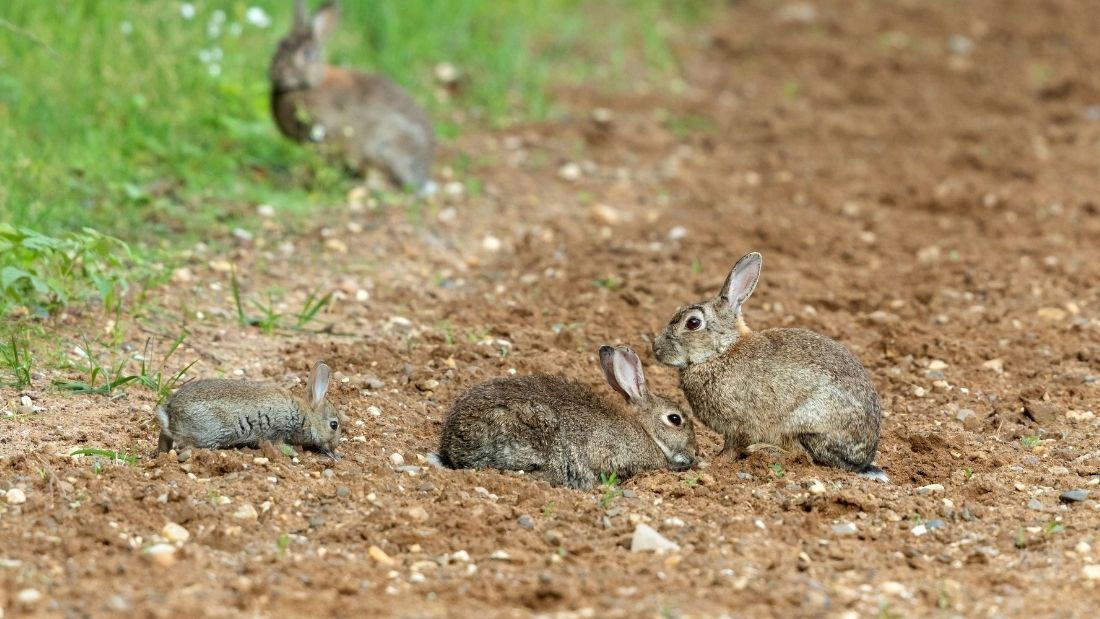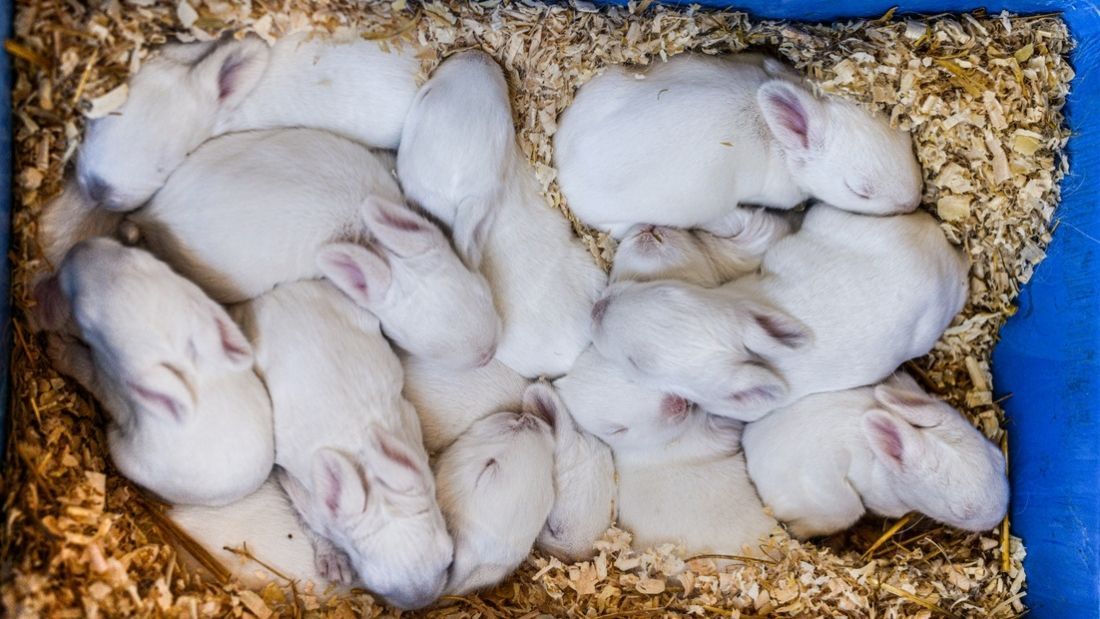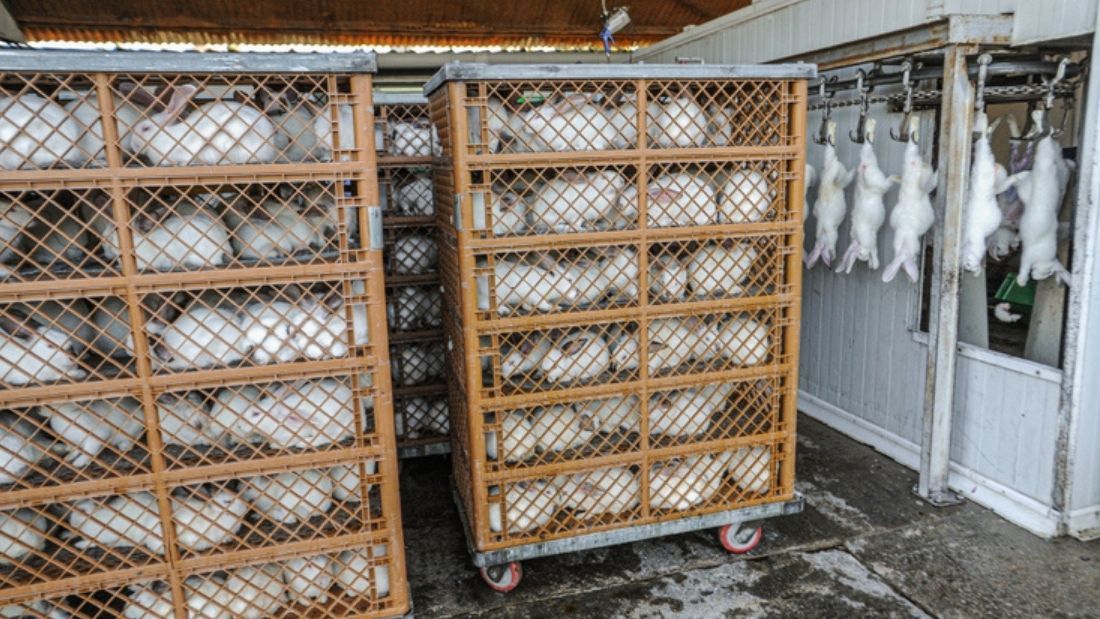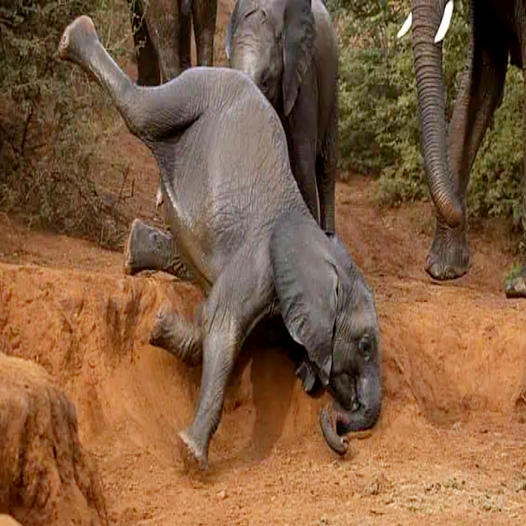
Fun facts about rabbits
- A rabbit’s teeth are constantly growing! Fortunately, they are worn down as the rabbit chews on grasses, wildflowers and vegetables so they never get overgrown.1
- Their ears grow pretty long too. A rabbit’s ears can grow up to ten centimetres in length and they can turn them through 180 degrees to listen out for predators.1
- Rabbits hop with happiness. When rabbits are excited, they will perform an athletic leap and twist into mid-air, known as a ‘binky’.1
- They have (almost) 360 vision! Because their eyes are positioned on the side of their heads, they can see almost all the way around them. Again, it is to help them keep a close watch for predators on open grasslands.1
- Rabbits purr just like cats! When they are content or relaxed, they let you know by making a purring sound.1
- Rabbits are the animal kingdom’s high jumpers, leaping as high as 90 centimetres in one leap!1
- They are truly prolific procreators. Females have up to 14 ‘kittens’ per litter and three to four litters per year!2
Prolific Procreators
The phrase ‘at it like rabbits’ exists for good reason – rabbits are very effective baby-makers! Mother rabbits give birth to up to 14 offspring with every litter and, since they’re only pregnant for 28 to 31 days, they can breed three to four times a year. In fact, after a doe (female rabbit) has had her litter, she can get pregnant the following day!
An average litter is more likely to produce three to eight ‘kits’ or ‘kittens’ and after just four to five weeks, kits can care for themselves. In two or three months, a female kit is able to reproduce and have a litter of her own.
The reason that they have so many offspring is because in the wild, only 15 per cent of kittens make it to their first birthday (Bradford, 2017). A doe who gives birth to litters with a high survival rate can produce up to 1,000 offspring in her lifetime.3. Sadly rabbits have many predators and most of the kittens do not survive. The Wild Rabbit is listed as Near Threatened on the IUCN red list as the population is declining due to disease, habitat loss and human-induced mortality.
There are currently estimated to be around 37.5 million wild rabbits in the UK.4
References
The natural life of rabbits
Rabbits belong to the family Leporidae, which includes the hare and the pika. There are 13 species of wild rabbit and 305 breeds of domestic rabbit.1
The world’s most common species is the European rabbit, which has been introduced on every continent except Antarctica.

European rabbit
Diet
Rabbits are herbivores, meaning they have a completely plant-based diet that includes grasses, clover, seeds, roots, tree bark, buds and some cruciferous plants, such as broccoli and Brussels sprouts. They are opportunistic feeders and therefore eat whatever they can find in their immediate habitat.
Habitats
While originally from Europe and Africa, rabbits are now found all over the world. They have a huge range of habitats, from woods and forests, to meadows and grasslands, deserts, tundra and wetlands.
Wild rabbits create their own homes by tunnelling into the ground and creating systems known as warrens which they use for nesting and sleeping. They can be as deep as three metres underground and have multiple entrances for a quick escape from predators.
Social bunnies
Rabbits are very social creatures and live in large groups called colonies. To avoid predators, they venture out of their warrens to find food at dawn and dusk when the light is lower and they are less likely to be spotted.
How long do rabbits live?
Rabbits are at constant threat of predators such as owls, eagles, hawks, feral cats, wild dogs and even domestic cats. The large number of animals wanting to eat them ensures that their life expectancy is only around one year in the wild. Domesticated rabbits will live an average of 8 to 12 years.2

References
The UK rabbit trade
Perhaps surprisingly, rabbits are the fourth most farmed animal in the world and the second most frequently farmed in the EU.1 In the EU alone, it’s estimated that over 300 million rabbits are slaughtered every year.2
Worryingly, very little is known about the size of the UK rabbit trade – which speaks to its utter lack of regulation. However, rabbit farming in the UK is generally considered to be fairly small scale.
The UK imports around 97 tonnes of rabbit, between 100,000 and 300,000 individuals, from the EU every year, all of whom will have been kept in appalling conditions.345
Other sources claim that the UK produces under 3000 tonnes of rabbit meat a year, importing an additional 5000 tonnes from China, Hungary, Poland and France.78
At the turn of the millennium there were about 400 rabbit producers in the UK, ranging from intensive factory farms to small garden operations.9 In 2011, it was estimated that one million rabbits a year were killed for meat in the UK.10

Credit: Jo-Anne McArthur – Animal Equality
References
Why rabbits are farmed
Rabbits are farmed for their meat, fur and wool, and some for animal experimentation.
Meat for human consumption
Rabbit is not commonly eaten in the UK and is seldom found in supermarkets. It is mainly used by restaurants supplied by “small producers running cottage industries that don’t always come to the attention of the relevant authorities” (Wood, 2016), but most is imported from the EU and China.1 A very small percentage comes from wild caught rabbits.
Meat for pet food
Rabbit meat can be found in pet food – primarily for dogs. Because there is so little data on the UK rabbit industry, it is difficult to determine what percentage of rabbits farmed end up in pet food.
The Pet Food Manufacturing Association2 states that only rabbit by-products from human consumption are used in pet food but these “by-products” will still provide an important source of income for the rabbit meat industry.
In 2019, a successful campaign removed all pet food containing intensively-farmed rabbit meat from UK supermarkets.3 Unfortunately it is still legal to sell pet food containing rabbit and can be found in many products, even if it isn’t on supermarket shelves.
Fur
The rabbit fur industry is the fastest growing section of the fur industry,4 with China producing more than half of the world’s rabbit fur. Although fur from China is low quality, because it is cheap it dominates the market. Fur that is considered “high quality” comes from Europe.5
Unlike mink, who are farmed specifically for their fur, rabbits are primarily farmed for their flesh and the fur is taken as a by-product. Although it is illegal to farm animals for their fur in the UK, it can be imported and sold, and the fur can still be taken from animals farmed for their meat as a by-product. However, there is little way of knowing which animals are killed for their meat and which are killed specifically for their fur.
- Find out more about Fur
Wool
Angora rabbits are farmed for their wool. Although they don’t have to be killed, the shearing process can be very painful and traumatic.

Credit: Jo-Anne McArthur – Animal Equality
References
How rabbits are farmed

Credit: Andrew Skowron
The breeds of rabbit that are commonly farmed include the New Zealand White, Californian and Carolina.
In the EU, the majority are intensively farmed – housed together in tiny wire cages where they have no more than a postcard of space each and a head height little more than the length of their ears. These cages are often stacked in two or more tiers in large sheds containing 10,000 to 20,000 animals raised for meat and around 1,000 breeding does.1
The cages are often made entirely of bare wire, making them incredibly uncomfortable for the rabbits to stand on and sores commonly develop on their feet and legs and can cause chronic pain, leading to many being prematurely culled (killed).
It has been reported that animals with open wounds are left without any treatment, live rabbits have been discarded in bins due to over-breeding, and even cannibalism has been witnessed amongst these herbivores.2
Just as on any intensive farm, where animals are housed in abhorrent, crowded conditions, disease is rife and antibiotic use is out of control. French rabbit farms use more antibiotics for rabbits (per kilogram of meat) than for any other farmed animal.3
Breeding cycle
Whereas male rabbits are crammed into overcrowded cages together, a breeding doe is isolated in a single cage where she is unable to even stretch out. The lack of stimulation and exercise leads to mental stress and weakened bones. As highly social and active animals, confining rabbits to a lifetime in a cage is nothing short of torture.
She will often be given hormone treatment to ensure she’s ready to breed at the same time as the other does. Like most factory-farmed animals, she will be artificially inseminated. Only 11 days after giving birth to her last litter, she will be inseminated again. The repeated pressure of this intensive reproduction cycle puts a huge strain on her body leading to a weakening of her bones and ultimately an early death.1
Baby rabbits – kittens – will be weaned at four weeks old when they are put into fattening cages. They are slaughtered for meat at around eight to 12 weeks old or when they’ve reached around 2 kg in weight.4 One in five rabbits will not survive until slaughter due to respiratory or intestinal diseases caused by their environment.3 A 2015 investigation found that newborn rabbits were often crushed to death against the cage wire or fell through the metal bars, to starve to death on the ground below.5

Credit: Jo-Anne McArthur – Animal Equality
References
How rabbits are killed

Credit: Jo-Anne McArthur – Animal Equality
In the EU, commercially slaughtered rabbits are usually electrically stunned by an electric water bath before slaughter. It involves them being shackled by their hind legs, which in itself often causes injury and distress, especially for larger rabbits. Hanging upside down, they are moved along an automatic production line and dipped in a water bath containing an electrical current supposedly strong enough to shock them unconscious. When the rabbit’s head touches the water, an electrical circuit between the water bath and the shackle is triggered and it is this that stuns them. They are then moved along the line to a mechanical neck cutter that severs the major blood vessels.
Research shows that rabbits are frequently stunned incorrectly and many are still conscious when they are slaughtered.1
On small scale farms in the UK (counted as killing less than 10,000 rabbits per year), farmers are allowed to stun and kill their own animals using a head-only electric stunning device. Since the minimum current for these devices isn’t set out in law – and there are few, if any checks – it is highly likely that killing isn’t always done efficiently and many animals will suffer agonising deaths. KIlling by blunt-force trauma is common practice within the rabbit industry.2




